You are reading the “early access” edition of INSIDER Xpresso newsletter’s (emTech) section.
On Wednesday, 9 October 2019, we will release the complete INSIDER Xpresso newsletter #08 to all subscribers. The newsletter from Architosh is free. Our Early Access editions of the popular Emerging Technologies section are for INSIDER members-only and include deeper commentary and more visuals than the newsletter itself. Our deeper analysis commentary will always be written in Architosh blue text.
Importantly, we usually deliver this “Early Access” feature—well, early! Unfortunately, this month I had a family medical emergency and it delayed this release by a week. To make up for that, our deeper analysis commentary is more extensive than in any past edition, and this is a trend I hope to continue going forward.
If you enjoy Architosh or our Xpresso newsletter, share your enthusiasm on Twitter or LinkedIn by clicking the social media buttons on this page. (thank you!).
Xpresso #08—What’s In This Issue
This issue is slightly more compact than previous versions. We discuss just three topics. The first is we go over who Xpresso readers are. We cover what percentage are Decision Makers and which are not. We also cover the spread of interest over various industries. Lastly, we cover what (emTech) topics they are most interested in.
In the middle section, we delve into a Harvard GSD student’s recent thesis on AI in Architecture. The entire thesis was only wrapped up this past May and is available online (link below). Two essays on Medium detail its main aspects and we dive into that.
Finally, we talk about Bricsys and its recent Boston Road Show visit. In particular, we are fascinated with its discussion of AI initiatives as discussed in Boston and we cover them in detail. As usual, for INSIDER Members reading this here on Architosh, I provide deeper analysis, commentary, and coverage than what is published in the newsletter, a unique benefit of being a subscriber.
TOC emTech #08
- Xpresso Reader Demographics and Reader Interest Areas (with commentary)
- Artificial Intelligence in Architecture: Harvard Thesis Published (with commentary)
- BricsysCAD BIM Event in Boston—AI Discuss (with commentary)
Who’s Reading Xpresso
Last month we said we would share some demographics about who is reading INSIDER Xpresso. Those signed up for this newsletter are overwhelmingly in the Architecture industry. Here’s the breakdown by industry (see graph).
As you can see, just about 6 out of every 10 readers are in the Architecture industry. Surprisingly, we have 1 out of 10 in the Software industry, tied with 1 out of 10 are the Engineering domains. So who is reading from the Software industry?
It turns out over 80 percent of those in the software industry are executives and 85 percent of readers in the software industry are working for AEC domain software companies, while the remaining 15 percent are investment analysts.
Further Commentary (INSIDER Members-only). 50 percent of all readers in the software category are either CEO, CTO, President or a VP. Of the following leading AEC software companies in no particular order—Autodesk, AMD, Bentley, Bricsys, Bluebeam, Graphisoft, Nemetschek, Solibri, Vectorworks and several leading VR software companies—80 percent of those listed above have senior-level or executive staff reading Architosh INSIDER Xpresso.
Clearly, Xpresso has caught the eye of top executives in the leading AEC software companies and we are thrilled that Xpresso, in just less than one year has garnered so much attention from the AEC software industry. In addition to this, the Software industry readers also consist of investment (VC) professionals and analysts on Wall Street—totaling 15 percent of this 10 percent segment of readers. It may not surprise folks to hear that over the past two decades, Architosh receives regular emails from Wall Street investment analysts, asking for market analysis information, typically for the AEC industry.
What Xpresso Readers Are Interested In
We also have some information on what Xpresso readers are interested in. While we ask just a few questions upon signing up for the newsletter, we asked for a multi-choice selection of interests (listed below):
- AI / ML (artificial intelligence and machine learning)
- AEC CAD/BIM
- Architectural Visualization (ArchViz)
- CAE, FEA and Simulation Technologies
- Computation and Algorithmic-Aided Design (AAD)
- CDE (common data environments) and Cloud-based Project Management Tools
- Robotics and Automation (including 3D printing)
- Drones and Laser Tech
- AR and VR Tech
- Process and Plant CAD/BIM
- MCAD and PLM
Given our dominant Architecture industry audience, with the next strongest segment being Engineering (10% of readers), it shouldn’t surprise folks that the least popular topics of those above are:
- MCAD and PLM
- Process and Plant CAD/BIM
- CAE, FEA and Simulation Tech
However, we were very surprised to learn that the number one topic of reader interests for our Xpresso readers wasn’t what we consider an Emergent Technology (emTech). Most of the selections above are emTech-related—or what we consider “edge-of-market” versus “center-market” technologies. For our INSIDER Members, we provide a very rare short break-down of the top three most interested in technologies from the list above.
Further Commentary (INSIDER Members-only). It turns out that INSIDER Xpresso readers are most interested in AEC CAD/BIM, with 70 percent of readers selecting that choice for interest. No other interest, emTech or otherwise, had more than 61 percent interest. But our top five most interested-in categories by Xpresso readers are (in scrambled order):
- VR / AR
- AEC CAD/BIM
- AI / ML
- ArchViz
- Computational Design / AAD
At least three of these technologies are Xpresso emTech darlings. We have written about Artificial Intelligence (AI / ML) in AEC a lot. This issue also focuses on that. We have also had very high-level VR, AR, and MR coverage in Xpresso in the Special Features section. In issue #08 we focus on 3D printing and additive manufacturing.
Robots Aren’t So Hot
It is important to note that we have spent considerable time addressing robotics and automation in AEC— which focuses on Architecture and Construction, more than Engineering. While I am particularly interested in robotics in AEC, only 4 out of 10 readers appear to be interested in this category. Bear in mind that 25 percent of all Xpresso readers are in either Engineering, Construction or the AEC-domain Software industry. While the AEC software industry is on the edge and looking into Robotics, and while the popular press talks incessantly about labor shortages in construction and Robotics as a kind of savior for the industry, it turns out that among Xpresso readers this just isn’t that popular.
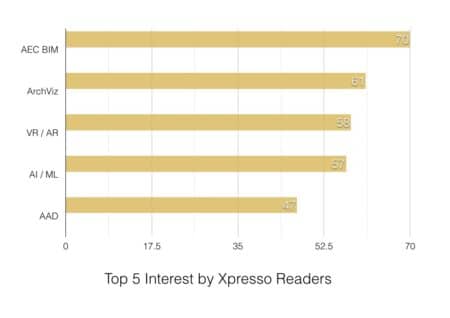
Xpresso readers are interested in a wide range of topics with VR/AR and AI/ML leading the (emTech) segment items. AAD is third while emergent technologies like Robotics lag behind these but not by much.
When we talk about “edge-of-market” (EoM)—a term Pete Evans and I first started using for our Perspectives on AIA BEST of SHOW awards here on Architosh—we mean both actual adoption and use of technologies but just as importantly, awareness within the industries of the availability of these technologies. Very EoM tech may have less than 1 percent adoption. Computational design, for example, may have less than 2 percent actual market adoption in AEC firms, despite the fact that architecture students have much higher use of AAD (algorithmic-aided design).
It is important to note that of the five leading topics listed above, there is only a 20 percent spread between them. And now that we are aware of these favorites, our Xpresso coverage will better reflect the actual favorites of readers.
AI in Architecture—Harvard Thesis on Medium
In May of 2019, Harvard Graduate School of Design (GSD) student, Stanislas Chaillou, submitted his graduate thesis on Artificial Intelligence and Architecture. He has published two long essays based on this thesis on Medium, which we will talk about in a minute. The entire thesis itself is available here, titled, “AI + Architecture: Towards a New Approach,” available at ACADEMIA.edu.
(AI) is creating the conditions of a reflexive empowerment: the machine could become a trustworthy ‘assistant’ provided professionals educate it, or properly ‘explain’ the job.
Stanislas Chaillou begins his thesis by stating that Artificial Intelligence (AI) is “creating the conditions of a reflexive empowerment: the machine could become a trustworthy ‘assistant’ provided professionals educate it, or properly ‘explain’ the job.”
Chaillou’s thesis closes by stating that AI in Architecture isn’t in doubt as to its existence or imposition to the field but rather that it faces the challenge of knowing its key role as an “intelligent assistant.”
Just as importantly if not more so, Chaillou’s thesis pays particular attention to noting that AI isn’t a sudden technological disruption—though some may argue this a different way in the form of a Clayton Christiansen innovator’s dilemma way—but rather it “is the culminating point of 70 years of inventions and innovations” in and around the world of Architecture and Computing.
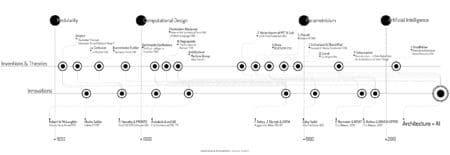
Inventions and Innovations, chart of progress towards AI in Architecture, by Stanislas Chaillou. (image: Stanislas Chaillou)
Chaillou’s these rests on research over 70 years of invention and innovation and on his timelines spans into four major periods of progress (1) Modularity, (2) Computational Design, (3) Parametricism, and (4) Artificial Intelligence. He says of these, they “are to us the four intricated steps of a slow-paced transition.”
Interestingly, Chaillou distinguishes between “inventions” and “innovations” as the former being associated with academic research, while innovations are induced by inventions. This idea may apply far more deeply to 20th-century digital innovation than to pre-digital industrialized progress. Carlota Perez roots each of her techno-economic paradigm (TEP) shifts (or Great Surges) from emanating from a singular invention. “In architecture, Innovations actually shape a continuously moving practice,” writes Chaillou.
Further Commentary (INSIDER Members-only).
At Architosh we have written a lot about Carlotta Perez, the British-Venezuelan scholar-historian specializing in technological-economic history as seen through her theory of great surges, a development based on Schumpeter’s work on Kondratieff waves. Chaillou’s terms “slow-paced transition” conjure up the visualization of the speed of ripples on the water after a pebble has been dropped into a still pond. This stillness or a false sense of stasis is just a period of time when a new “common sense” pervades society about how to go about doing things. Chaillou doesn’t take his four periods of evolution in Architecture towards AI and ground them in larger Kondratieff waves of technological progress, but he does emphasis emphasize evolution rather than dramatizing disruption.
His Four Periods—Towards AI in Architecture
Chaillou has Inventions and Theories on its own timeline compared to Innovations. You can see his interesting chart graphic here (or the screen capture above). He shows the world of architecture and computer science moving from Modularity to Computational Design to Parametricism and finally to AI. To read his full two-part essay go here.
Further Commentary (INSIDER Members-only)
Chaillou’s timeline and its connections are quite interesting as origins for AI in Architecture. It seems reasonable to begin with Gropius’ “Baukastan” concept, a german word that translates to “construction kit.” The concept of modularity results in key terms like “grid” and “component” and leads to the world of buildings becoming further standardized.
Walking through the history of CAD is to be expected in an essay like this but Chaillou lays emphasis on Christopher Alexander’s Notes on the Synthesis of Form written by the architecture and UC Berkley professor, a book that I was unaware had such a large impact on the software community. From Alexander to Negroponte at MIT to Gehry and Jim Glymph at Gehry Technologies, Chaillou tracks the history of computational design as CAD (computer-aided design). But eventually, it is Gehry’s work that requires control over more complex shapes that help lead our way to parametricism.
Ivan Sutherland’s SketchPad with the embedded notion of an “atomic constraint” combines with Professor Luigi Moretti’s first ideas of parameterization. These ideas formulate together for Samuel Giesberg, founder of Parametric Technology Corporation (PTC), and lead to Pro/ENGINEER. From here it is Schumacher and Zaha Hadid that lead to David Rutten’s development of Grasshopper and the evolution of algorithmic-aided design (AAD).
Chaillou’s thesis begins to break down when he talks about BIM’s origins, however. Noting correctly that BIM too is driven by parameterization, he states it “started in the early 2000’s” when in fact BIM, as a shipping product, began with the Virtual Building concept by GRAPHISOFT.
BricsysCAD BIM Event in Boston—AI Discuss
Back in late mid-September, the Bricsys folks were in Boston for an “international Road Show” of BricsCAD and AI. I attended this event with great enthusiasm and wondered how many people would show up. It was held at the Boston Society of Architects (BSA) building in downtown Boston and in the same room as most user-group meetings for various BIM platforms.
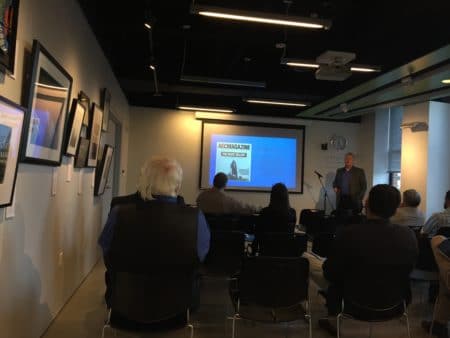
The Bricsys folks fancy themselves Revit killers. Could they be right? Their Boston event last month was quite well-attended for a company supposedly nobody knows about. Shocking, right?
My first comment about this even was the utter surprise of finding so many folks in attendance. Big names in the world of AutoCAD were there, including former Autodesk employee Heidi Hewett, now Product Owner, Bricsys/Hexagon PPM. Robert Green, also well-known in the world of AutoCAD and newly minted Director of Implementation, Bricsys/Hexagon PPM.
A considerable part of this event focused on the AI side of things for BricsCAD BIM. This is what we want to focus on in this (emTech) section.
Intelligent Collaboration Between Designer and Machine
Bricsys has a fairly large team devoted to artificial intelligence (AI). In one slide at the event, I got to see pictures of the folks involved in the AI team. It wasn’t one or two AI specialists. It was bigger than that. (see Commentary below).
The Machine
Don Stribu, VP Communications, Bricsys/Hexagon PPM, delivered the interesting AI section of the presentation. Because it was here that they laid out the rough framework for how AI interfaces the human designer. Stribu started by asking the question, what is the AI good for versus what is the human good for? Here’s where AI can help:
- Repetitive Tasks — common CAD/BIM today is filled with repetitive tasks, from completing dialog boxes, repeating common elements, etc. Bricsys is looking at all forms of repetitive tasks and looking at how AI can do these tasks partly or completely for the human designer. This speeds up work, saves time and money and even errors.
- Design Documentation — Bricsys knows that you can train AI’s to learn and understand; they can be trained to recognize patterns. For example, given a particular building design, where should cross-sections of the building be drawn? They are working on training AI to understand this and to just implement them automatically without human intervention. If the human disagrees, they can easily override the choice and move sections to other parts of the building.
- Local Solutions Based on Experience — this is where AI gets really interesting. By seeing how various details are dealt with in other areas of the building, the AI can complete the details in similar areas.
- Style suggestions as inspiration — a more questionable area for AI integration, an AI can find sources of inspiration based on example inputs.
- Complexity Management — this is a very good area where AI can aid human designers by helping to oversee complexity in a project and alert human architects to areas of concern.
- Verification of Design Goals — AIs can run tests to verify that building designs are meeting stated goals and building codes compliance.
Before we move on to what the Human does best versus the AI, let me share some of my thoughts based on 30 plus years of practice in architecture.
Further Commentary (INSIDER Members-only).
BricysCAD BIM’s best AI-inspired technology thus far, in my view, is the BIMify technology that enables human designers to freely model and let the system self-assign elements to correct classification—that is, this is a roof, a floor, a column, a window, etc. This removes an awkward step in design: pre-selecting element types in order to model or create architecture.
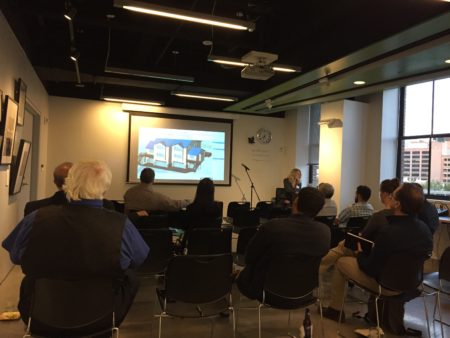
Heidi Hewett is a well-known name in the AutoCAD world. But she has moved to Bricsys because she believes in their technologies.
What architects like myself really want to see with AI is a way to dramatically accelerate our processes—particularly construction documents but also getting from design models to construction documents. Bricsys needs to also think about AAD (algorithmic-aided design) tools and how designers can parameterize complex overall forms that drive (child) dependent forms and elements. But we understand that the Hexagon company has plans to achieve this with the help of the Rhino+Grasshopper folks.
The Human
Where do Bricsys think the human has their strengths? From the slide above this is where:
- Identifying design goals — human architects will feed the system with the necessary data so that AIs can understand what the goals are.
- Prototyping — just as AI’s will be trained to automatically generate coordinated drawing documentation, they will also generate prototype designs for humans to evaluate.
- Style and Detail Choices — naturally human architects will rule in the area of architectural expression—style, history, contextualization, material and color selections, etc.
- Aesthetics — same as above, humans will handle all aesthetics considerations in terms of final decisions.
- Constructive Feedback — humans will train AIs via feedback loops that strengthen AIs to better help them with the AI tasks listed above
- Innovation — only humans can do true innovation.
The Bricsys folks admit that many of these bullet points are still goals for them and they have no serious solutions with AI in all of these areas, but they are working very hard on them. Part of their overall argument is that they feel they have a very strong AI team that can bring industry-first innovations to the use of artificial intelligence to BIM in the AEC market.
Further Commentary (INSIDER Members-only)
So Bricsys has an AI R&D team size of approximately 10 people. This isn’t paltry but it also isn’t massive. Given their overall team size the size of this team looks appropriately aggressive in terms of pushing for advancements in artificial intelligence (AI) in BIM.
Final Comments
The (emTech) section of Issue #08 of our monthly newsletter (INSIDER Xpresso) is a bit different this month. We just focused a bit more on a few items rather than cover lots and lots of other topics across a range of our emergent technologies focuses. Please let us know how you like this format or if you prefer us covering more topics but at a thinner coverage level. You can write to us at Xpresso@architosh.com
Please be sure to read the Special Feature in the email newsletter. And if you are an INSIDER Member subscriber reading this, please consider subscribing to our free Xpresso newsletter.

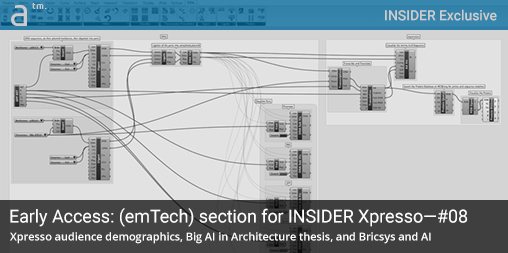
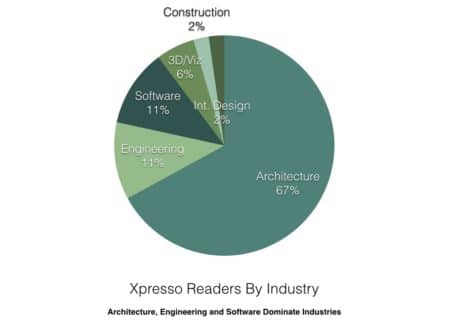
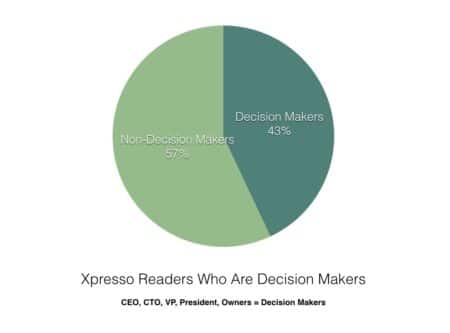


Reader Comments
Comments for this story are closed